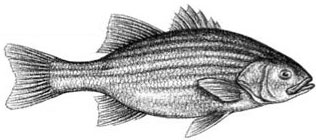Appearance

Scientific Name
Morone saxatilis
Market Forms
Whole, filet, fresh or frozen. Size
Range between 2 and 20 pounds. Taste/Texture
White, flaky meat with a light, mild-to-moderate flavor. Seasonality
Available year round. Nutritional Value
97 Calories (100 mg., 3.5 oz.)
17.7% Protein
2.3% Fat
.75% Omega 3 Substitutability
This fish can be substituted for a number of other species, including grouper, red snapper, halibut, black sea bass, Lake Victoria perch and Chilean sea bass. Folklore
Regionally known as “rockfish,” striped bass travel in schools preying on smaller fish.A fish prized for its high quality meat, the striped bass has been immensely popular since Colonial times, as the fact that it was one of the first natural resources to benefit from a 1639 conservation statute attests.The first free public school of the New World and pension funds for the widows and orphans of men formerly engaged in service to the Colony were also funded, in part, through monies derived from the sale of striped bass. It remains tremendously popular today, both as a commercial and recreational catch. Harvesting
Striped bass are harvested along Virginia’s coast by traditional use of haul seines, otter trawl, pound nets, gill nets, commercial-hook and line. Safety/Quality
Virginia’s waters and products are regulated by federal and state agencies including the FDA, the Virginia Department of Health, the Virginia Department of Agriculture and Consumer Services, the Virginia Department of Environmental Quality, and the Virginia Marine Resources Commission, insuring that only safe wholesome seafood reaches our customers.

